ASUS P5PL2 User Manual

P5PL2
Motherboard

E2233

First
 Edition
Edition

September 2005
Copyright © 2005 ASUSTeK COMPUTER INC. All Rights Reserved.
No part of this manual, including the products and software described in it, may be reproduced, transmitted, transcribed, stored in a retrieval system, or translated into any language in any form or by any means, except documentation kept by the purchaser for backup purposes, without the express written permission of ASUSTeK COMPUTER INC. (“ASUS”).
Product warranty or service will not be extended if: (1) the product is repaired, modified or altered, unless such repair, modification of alteration is authorized in writing byASUS; or (2) the serial number of the product is defaced or missing.
ASUS PROVIDES THIS MANUAL “AS IS” WITHOUT WARRANTY OFANY KIND, EITHER EXPRESS OR IMPLIED, INCLUDING BUT NOT LIMITED TO THE IMPLIED WARRANTIES OR CONDITIONS OF MERCHANTABILITY OR FITNESS FORAPARTICULAR PURPOSE. IN NO EVENT SHALLASUS, ITS DIRECTORS, OFFICERS, EMPLOYEES ORAGENTS BE LIABLE FORANY INDIRECT, SPECIAL, INCIDENTAL, OR CONSEQUENTIAL DAMAGES (INCLUDING DAMAGES FOR LOSS OF PROFITS, LOSS OF BUSINESS, LOSS OF USE OR DATA, INTERRUPTION OF BUSINESSAND THE LIKE), EVEN IFASUS HAS BEEN ADVISED OF THE POSSIBILITY OF SUCH DAMAGESARISING FROMANY DEFECT OR ERROR IN THIS MANUAL OR PRODUCT.
SPECIFICATIONSAND INFORMATION CONTAINED IN THIS MANUALARE FURNISHED FOR INFORMATIONAL USE ONLY,ANDARE SUBJECT TO CHANGEATANY TIME WITHOUT NOTICE,AND SHOULD NOT BE CONSTRUEDASACOMMITMENT BY ASUS.ASUSASSUMES NO RESPONSIBILITY OR LIABILITY FORANY ERRORS OR INACCURACIES THAT MAYAPPEAR IN THIS MANUAL, INCLUDING THE PRODUCTS AND SOFTWARE DESCRIBED IN IT.
Products and corporate names appearing in this manual may or may not be registered trademarks or copyrights of their respective companies, and are used only for identification or explanation and to the owners’ benefit, without intent to infringe.
ii




Contents
Notices................................................................................................ |
vi |
Safety information ............................................................................. |
vii |
About this guide................................................................................. |
viii |
P5PL2 specifications summary............................................................. |
x |
Chapter 1: Product introduction
1.1 |
Welcome!.............................................................................. |
1-1 |
|
1.2 |
Package contents ................................................................. |
1-1 |
|
1.3 |
Special features.................................................................... |
1-2 |
|
|
1.3.1 |
Product highlights................................................... |
1-2 |
|
1.3.2 |
Innovative ASUS features ....................................... |
1-3 |
Chapter 2: Hardware information
2.1 |
Before you proceed .............................................................. |
2-1 |
|
2.2 |
Motherboard overview.......................................................... |
2-2 |
|
|
2.2.1 |
Placement direction ................................................ |
2-2 |
|
2.2.2 |
Screw holes............................................................. |
2-2 |
|
2.2.3 |
Motherboard layout ................................................ |
2-3 |
|
2.2.4 |
Layout contents ..................................................... |
2-4 |
2.3 |
Central Processing Unit (CPU) .............................................. |
2-6 |
|
|
2.3.1 |
Installing the CPU.................................................... |
2-6 |
|
2.3.2 Installing the CPU heatsink and fan......................... |
2-9 |
|
|
2.3.3 Uninstalling the CPU heatsink and fan................... |
2-11 |
|
2.4 |
System memory.................................................................. |
2-13 |
|
|
2.4.1 |
Overview............................................................... |
2-13 |
|
2.4.2 |
Memory configurations ......................................... |
2-13 |
|
2.4.3 |
Installing a DIMM ................................................... |
2-15 |
|
2.4.4 |
Removing a DIMM.................................................. |
2-15 |
2.5 |
Expansion slots................................................................... |
2-16 |
|
|
2.5.1 Installing an expansion card.................................. |
2-16 |
|
|
2.5.2 Configuring an expansion card.............................. |
2-16 |
|
|
2.5.3 |
Interrupt assignments........................................... |
2-17 |
|
2.5.4 |
PCI slots................................................................ |
2-18 |
|
2.5.5 PCI Express x16 slot ............................................. |
2-18 |
|
|
2.5.6 PCI Express x1 slots.............................................. |
2-18 |
|
2.6 |
Jumpers |
.............................................................................. |
2-19 |
iii




Contents
2.7 Connectors ......................................................................... |
2-21 |
|
2.7.1 |
Rear panel connectors .......................................... |
2-21 |
2.7.2 |
Internal connectors............................................... |
2-22 |
Chapter 3: Powering up
3.1 |
Starting up for the first time................................................ |
3-1 |
|
3.2 |
Powering off the computer................................................... |
3-2 |
|
|
3.2.1 |
Using the OS shut down function ........................... |
3-2 |
|
3.2.2 |
Using the dual function power switch..................... |
3-2 |
Chapter 4: BIOS setup
4.1 Managing and updating your BIOS ........................................ |
4-1 |
||
|
4.1.1 Creating a bootable floppy disk.............................. |
4-1 |
|
|
4.1.2 |
ASUS utility............................................................. |
4-2 |
|
4.1.3 ASUS CrashFree BIOS 2 utility ................................ |
4-5 |
|
|
4.1.4 ASUS EZ Flash utility............................................... |
4-7 |
|
|
4.1.5 |
ASUS Update utility ................................................ |
4-8 |
4.2 |
BIOS setup program............................................................ |
4-11 |
|
|
4.2.1 |
Menu bar............................................................... |
4-12 |
|
4.2.2 |
Navigation keys..................................................... |
4-12 |
|
4.2.3 |
BIOS menu screen................................................. |
4-12 |
|
4.2.4 |
Menu items ........................................................... |
4-13 |
|
4.2.5 |
Sub-menu items.................................................... |
4-13 |
|
4.2.6 |
Configuration fields............................................... |
4-13 |
|
4.2.7 |
Pop-up window...................................................... |
4-13 |
|
4.2.8 |
Scroll bar............................................................... |
4-13 |
|
4.2.9 |
General help .......................................................... |
4-13 |
4.3 |
Main menu........................................................................... |
4-14 |
|
|
4.3.1 |
System Time ........................................................ |
4-14 |
|
4.3.2 |
System Date ....................................................... |
4-14 |
|
4.3.3 |
Legacy Diskette A .............................................. |
4-14 |
|
4.3.4 Primary and Secondary IDE Master/Slave ............. |
4-15 |
|
|
4.3.5 |
IDE Configuration .................................................. |
4-16 |
|
4.3.6 |
System Information .............................................. |
4-18 |
4.4 |
Advanced menu.................................................................. |
4-19 |
|
|
4.4.1 |
JumperFree Configuration..................................... |
4-19 |
iv


Contents
|
4.4.2 |
USB Configuration................................................. |
4-22 |
|
4.4.3 |
CPU Configuration................................................. |
4-23 |
|
4.4.4 |
Chipset.................................................................. |
4-24 |
|
4.4.5 |
Onboard Devices Configuration............................. |
4-26 |
|
4.4.6 |
PCI PnP.................................................................. |
4-28 |
4.5 |
Power menu........................................................................ |
4-30 |
|
|
4.5.1 |
Suspend Mode .................................................... |
4-30 |
|
4.5.2 Repost Video on S3 Resume ................................ |
4-30 |
|
|
4.5.3 |
ACPI 2.0 Support ................................................ |
4-30 |
|
4.5.4 |
ACPI APIC Support .............................................. |
4-30 |
|
4.5.5 |
APM Configuration ................................................ |
4-31 |
|
4.5.6 |
Hardware Monitor.................................................. |
4-33 |
4.6 |
Boot menu.......................................................................... |
4-35 |
|
|
4.6.1 |
Boot Device Priority.............................................. |
4-35 |
|
4.6.2 |
Boot Settings Configuration ................................ |
4-36 |
|
4.6.3 |
Security................................................................. |
4-37 |
4.7 |
Exit menu............................................................................ |
4-40 |
|
Chapter 5: Software support
5.1 |
Installing an operating system.............................................. |
5-1 |
|
5.2 |
Support CD information........................................................ |
5-1 |
|
|
5.2.1 Running the support CD.......................................... |
5-1 |
|
|
5.2.2 |
Drivers menu........................................................... |
5-2 |
|
5.2.3 |
Utilities menu.......................................................... |
5-3 |
|
5.2.4 |
Manuals menu ......................................................... |
5-5 |
|
5.2.5 |
Contact information................................................ |
5-6 |
|
5.2.6 |
Other information ................................................... |
5-6 |
5.3 |
ASUS MyLogo™..................................................................... |
5-8 |
|
Appendix: CPU features
A.1 |
Intel® EM64T......................................................................... |
A-1 |
|
A.2 |
Enhanced Intel SpeedStep® Technology (EIST) .................... |
A-1 |
|
|
A.2.1 |
System requirements.............................................. |
A-1 |
|
A.2.2 |
Using the EIST......................................................... |
A-2 |
A.3 |
Intel® Hyper-Threading Technology...................................... |
A-3 |
|
|
Using the Hyper-Threading Technology ............................... |
A-3 |
|
v

Notices
Federal

 Communications Commission Statement
Communications Commission Statement
This device complies with Part 15 of the FCC Rules. Operation is subject to the following two conditions:
•This device may not cause harmful interference, and
•This device must accept any interference received including interference that may cause undesired operation.
This equipment has been tested and found to comply with the limits for a Class B digital device, pursuant to Part 15 of the FCC Rules. These limits are designed to provide reasonable protection against harmful interference in a residential installation. This equipment generates, uses and can radiate radio frequency energy and, if not installed and used in accordance with manufacturerʼs instructions, may cause harmful interference to radio communications. However, there is no guarantee that interference will not occur in a particular installation. If this equipment does cause harmful interference to radio or television reception, which can be determined by turning the equipment off and on, the user is encouraged to try to correct the interference by one or more of the following measures:
•Reorient or relocate the receiving antenna.
•Increase the separation between the equipment and receiver.
•Connect the equipment to an outlet on a circuit different from that to which the receiver is connected.
•Consult the dealer or an experienced radio/TV technician for help.
The use of shielded cables for connection of the monitor to the graphics card is required to assure compliance with FCC regulations. Changes
or modifications to this unit not expressly approved by the party responsible for compliance could void the userʼs authority to operate this equipment.
Canadian Department of Communications Statement
This digital apparatus does not exceed the Class B limits for radio noise emissions from digital apparatus set out in the Radio Interference Regulations of the Canadian Department of Communications.
This class B digital apparatus complies with Canadian ICES-003.
vi

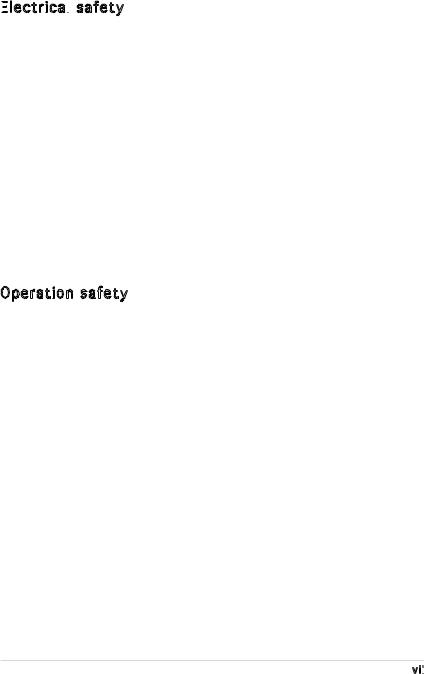
Safety information
Electrical

 safety
safety
•To prevent electrical shock hazard, disconnect the power cable from the electrical outlet before relocating the system.
•When adding or removing devices to or from the system, ensure that the power cables for the devices are unplugged before the signal cables are connected. If possible, disconnect all power cables from the existing system before you add a device.
•Before connecting or removing signal cables from the motherboard, ensure that all power cables are unplugged.
•Seek professional assistance before using an adpater or extension cord. These devices could interrupt the grounding circuit.
•Make sure that your power supply is set to the correct voltage in your area. If you are not sure about the voltage of the electrical outlet you are using, contact your local power company.
•If the power supply is broken, do not try to fix it by yourself. Contact a qualified service technician or your retailer.
Operation safety
•Before installing the motherboard and adding devices on it, carefully read all the manuals that came with the package.
•Before using the product, make sure all cables are correctly connected and the power cables are not damaged. If you detect any damage, contact your dealer immediately.
•To avoid short circuits, keep paper clips, screws, and staples away from connectors, slots, sockets and circuitry.
•Avoid dust, humidity, and temperature extremes. Do not place the product in any area where it may become wet.
•Place the product on a stable surface.
•If you encounter technical problems with the product, contact a qualified service technician or your retailer.
vii

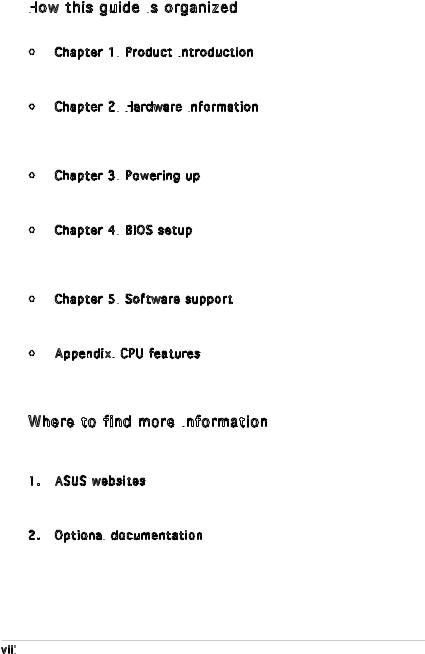
About this guide
This user guide contains the information you need when installing and configuring the motherboard.
How
 this guide is
this guide is organized
organized
This guide contains the following parts:
•Chapter 1: Product introduction
Product introduction
This chapter describes the features of the motherboard and the new technology it supports.
•Chapter 2: Hardware
Hardware
 information
information
This chapter lists the hardware setup procedures that you have to perform when installing system components. It includes description of the switches, jumpers, and connectors on the motherboard.
•Chapter 3: Powering up
Powering up
This chapter describes the power up sequence, the vocal POST messages, and ways of shutting down the system.
•Chapter 4: BIOS setup
BIOS setup
This chapter tells how to change system settings through the BIOS Setup menus. Detailed descriptions of the BIOS parameters are also provided.
•Chapter 5: Software support
Software support
This chapter describes the contents of the support CD that comes with the motherboard package.
•Appendix: CPU features
CPU features
The Appendix describes the CPU features that the motherboard supports.
Where to find more information
Refer to the following sources for additional information and for product and software updates.
1.ASUS websites
The ASUS website provides updated information on ASUS hardware and software products. Refer to the ASUS contact information.
2.Optional
 documentation
documentation
Your product package may include optional documentation, such as warranty flyers, that may have been added by your dealer. These documents are not part of the standard package.
viii


Conventions used in this guide
this guide
To make sure that you perform certain tasks properly, take note of the following symbols used throughout this manual.
DANGER/WARNING: Information to prevent injury to yourself when trying to complete a task.
CAUTION: Information to prevent damage to the components when trying to complete a task.
IMPORTANT: Instructions that you MUST follow to complete a task.
NOTE: Tips and additional information to help you complete a task.
Typography

Bold text |
Indicates a menu or an item to select. |
Italics |
Used to emphasize a word or a phrase. |
<Key> |
Keys enclosed in the less-than and greater-than |
|
sign means that you must press the enclosed key. |
|
Example: <Enter> means that you must press the |
|
Enter or Return key. |
<Key1>+<Key2>+<Key3> If you must press two or more keys simultaneously, the key names are linked with a plus sign (+).
|
Example: <Ctrl>+<Alt>+<D> |
Command |
Means that you must type the command exactly |
|
as shown, then supply the required item or value |
|
enclosed in brackets. |
|
Example: At the DOS prompt, type the command |
|
line: |
|
afudos /i[filename] |
|
afudos /iP5PL2.ROM |
ix

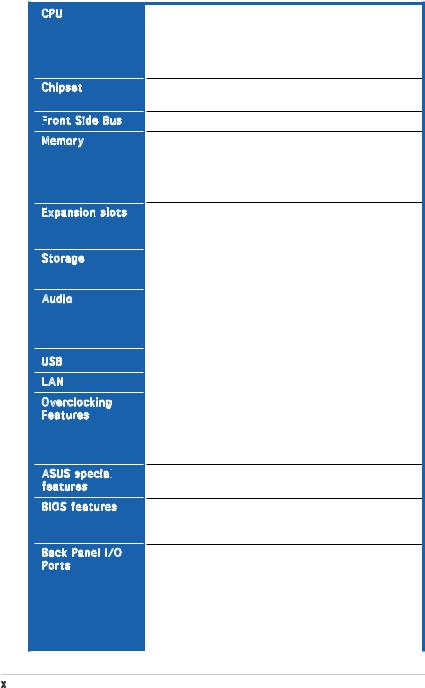
P5PL2 specifications summary
CPU
Chipset
Front
 Side Bus
Side Bus
Memory
Socket 775 for Intel Pentium D/ Pentium 4/ Celeron processors
Supports Intel® EM64T/ EIST/Hyper-Threading Technology
Supports Intel® 04B/04A and 05B/05A processor
Northbridge: Intel® 945PL
Southbridge: Intel® ICH7
800/533 MHz
Dual-channel memory architecture
4 x 240-pin DIMM sockets support unbufferred non-ECC DDR2 400/533 memory modules
Supports up to 2 GB system memory
(Note: Each channel supports two banks only.)
Expansion slots |
1 x PCI-E x16 slot for discrete graphic card |
|
2 x PCI-E x1 slots |
|
3 x PCI slots |
|
|
Storage |
Intel® ICH7 South Bridge supports: |
|
- 1 x Ultra DMA 100/66/33 |
|
- 4 x Serial ATA 3Gb/s devices |
Audio |
ADI 1986A 6-channel audio |
|
|
|
Supports Jack Sensing and Enumeration Technology |
|
Supports Universal Audio Jack |
|
S/PDIF out interface |
USB |
Supports up to 8 USB 2.0 ports |
LAN |
RTL8111B 1000/100/10 Ethernet LAN |
Overclocking |
|
ASUS C.P.R. (CPU Parameter Recall) |
|
Features |
Adjustable CPU voltage at 0.0125 V increment |
|
SFS (Stepless Frenquency Selection) from 100MHz up |
|
to 450 MHz at 1MHz increment |
|
4-Step DRAM voltage control |
ASUS special
 features
features
BIOS features
ASUS CrashFree BIOS 2
ASUS Q-Fan
4 Mb Flash ROM, AMI BIOS , PnP, DMI2.0, WfM2.0, SM BIOS 2.3, ASUS EZ Flash, ASUS CrashFree BIOS 2, ASUS MyLogo
Back Panel I/O |
1 x Parallel port |
Ports |
1 x Serial port |
|
1 x S/PDIF Out port |
|
1 x PS/2 keyboard port |
|
1 x PS/2 mouse port |
|
1 x RJ45 |
|
4 x USB 2.0/1.1 |
|
6-Channel Audio I/O |
|
(continued on the next page) |
x

P5PL2 specifications summary
Internal

 I/O
I/O connectors
connectors
Manageability
Support CD contents
Accessories
Form
 Factor
Factor

1 x 24-pin ATX power connector
1 x 4-pin ATX 12V power connector
2 x USB connectors for 4 additional USB 2.0 ports 1 x CD audio-in connector
1 x GAME/MIDI connector
1 x Front panel High Definition Audio connector Chassis Intrusion
CPU/Chassis/ Power Fan connectors
WOL by PME, WOR by PME, Chassis Intrusion
Drivers
ASUS PC Probe II
ASUS LiveUpdate Utility
Anti-Virus software
AI Booster
1 x IDE cable
2 x SATA cable
1 x SATA power cables for 2 SATA Devices
1 x UltraDMA 133/100/66 cable
1 x FDD cable
1 x I/O Shield Userʼs manual
ATX Form Factor, 12”x7.5”(30.5cm x 18.8cm)
*Specifications are subject to change without notice.
xi


xii

This chapter describes the motherboard |
1 |
|
|
||
features and the new technologies |
|
|
it supports. |
|
Product |
|
|
|
|
introduction |
|

|
Chapter summary |
1 |
|
|
|
1.1 |
Welcome!.............................................................................. |
1-1 |
1.2 |
Package contents ................................................................. |
1-1 |
1.3 |
Special features.................................................................... |
1-2 |
ASUS P5PL2
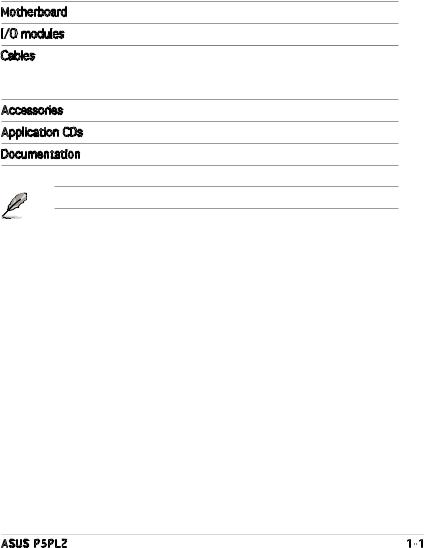
1.1Welcome!
Thank you for buying an ASUS® P5PL2 motherboard!
The motherboard delivers a host of new features and latest technologies, making it another standout in the long line of ASUS quality motherboards!
Before you start installing the motherboard, and hardware devices on it, check the items in your package with the list below.
1.2Package contents
Check your motherboard package for the following items.
Motherboard |
ASUS P5PL2 motherboard |
I/O modules |
USB 2.0 (2 ports) module |
Cables |
1 x 2 in 1 ATA/FDD cable |
|
2 x SATA cables |
|
2 x SATA power cables |
Accessories |
I/O shield |
Application CDs |
ASUS motherboard support CD |
Documentation |
User guide |
If any of the above items is damaged or missing, contact your retailer.
ASUS P5PL2 |
1-1 |
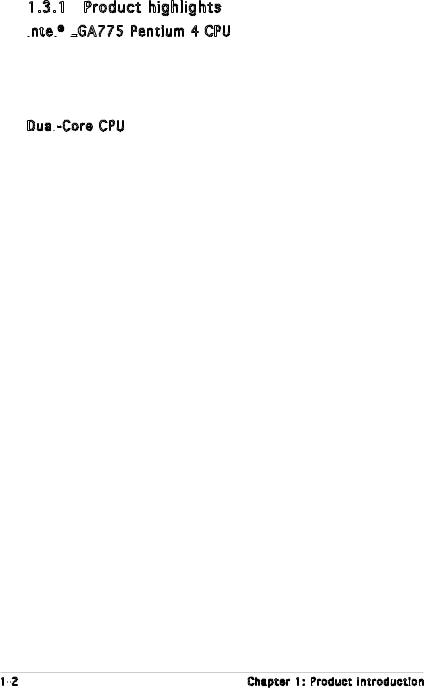
1.3Special features
1.3.1Product highlights
Intel


 ® LGA775
® LGA775
 Pentium 4 CPU
Pentium 4 CPU 

This motherboard supports the latest Pentium 4 CPU from Intel in LGA775 package. With 800/533MHz FSB, Hyper-Threading Technology and corespeeds up to 3.8GHz and beyond, Intelʼs LGA775 Pentium 4 is one of the fastest desktop processors to date. See page 2-6 for details.
Dual
 -Core CPU
-Core CPU
Enjoy the extraordinary CPU power from the latest dual-core CPU. The advanced processing technology contains two physical CPU cores with individually dedicated L2 cache to satisfy the rising demand for more powerful processing capability.
64-bit CPU support 
64-bit computing, the next generation technology to replace current 32-bit architecture, delivers advanced system performance, faster memory access and increased productivity. This motherboard provides excellent compatibility and flexibility by supporting either 64-bit or 32-bit architecture.
Dual
 Channel
Channel
 DDRII
DDRII
 533
533 
DDR2 is the next generation memory technology to replace the current DDR. With initial speeds of 400 and 533MHz, DDR2 memory provides bandwidth up to 4.3GB/s. Doubled by the dual-channel architecture, the widest memory bus bandwidth 8.6GB/s is achieved on this motherboard.
6 Channel
 Audio and SoundMax Digital
Audio and SoundMax Digital
 Audio
Audio 





SoundMAX Digital Audio System can output 5.1 channel surround sound and features state-of-the-art DLS2 MIDI synthesizer with Yamaha DLSbyXG sound set, 5.1 Virtual TheaterTM and supports and major game audio technologies including Microsoft DirectXTM 8.0, Microsoft DirectSound 3D, A3D, MacroFX, ZoomFX, MultiDrive 5.1, A3D and EAX. See pages 2-21 to 2-22 for details.
Serial
 ATA technology
ATA technology 
The motherboard supports the Serial ATA technology through the Serial ATA interfaces. The SATA specification allows for thinner, more flexible cables with lower pin count, reduced voltage requirement, and up to 300 MB/s data transfer rate. See pages 2-24 for details.
1-2 |
Chapter 1: Product introduction |

S/PDIF
 -out on Back I/O
-out on Back I/O
 Port
Port
This motherboard provides convenient connectivity to external home theater audio systems via an S/PDIF-out (SONY-PHILIPS Digital Interface) jack. It allows to transfer digital audio without converting to analog format and keeps the best signal quality. See pages 2-22 for details.
PCI
 Express™
Express™
 interface
interface

The motherboard fully supports PCI Express, the latest I/O interconnect technology that speeds up the PCI bus. PCI Express features point-to-point serial interconnections between devices and allows higher clockspeeds by carrying data in packets. This high speed interface is software compatible with existing PCI specifications. See page 2-18 for details.
ASUS CPU Lock
 Free
Free


This feature allows you to adjust the CPU multiplier to 14x. Setting the appropriate BIOS setting automatically reduces the CPU multiplier value for more flexibility when increasing external FSB.
1.3.2Innovative ASUS features
ASUS features
C.P.R. (CPU Parameter Recall)
The C.P.R. feature of the motherboard BIOS allows automatic re-setting to the BIOS default settings in case the system hangs due to overclocking. When the system hangs due to overclocking, C.P.R. eliminates the need to open the system chassis and clear the RTC data. Simply shut down and reboot the system, and the BIOS automatically restores the CPU default setting for each parameter.
CrashFree BIOS 2 
This feature allows you to restore the original BIOS data from the support CD in case when the BIOS codes and data are corrupted. This protection eliminates the need to buy a replacement ROM chip. See page 4-5 for details.
ASUS Q-Fan
 technology
technology 
The ASUS Q-Fan technology smartly adjusts the fan speeds according to the system loading to ensure quiet, cool, and efficient operation.
See page 4-34 for details.
ASUS MyLogo™
This new feature present in the motherboard allows you to personalize and add style to your system with customizable boot logos. See page 5-8 for details.
ASUS P5PL2 |
1-3 |

1-4
Chapter 1: Product introduction
Product introduction

This chapter lists the hardware setup procedures that you have to perform when installing system components. It includes description of the jumpers and connectors on the motherboard.
Hardware2 information

|
Chapter summary |
2 |
|
|
|
2.1 |
Before you proceed .............................................................. |
2-1 |
2.2 |
Motherboard overview.......................................................... |
2-2 |
2.3 |
Central Processing Unit (CPU) .............................................. |
2-6 |
2.4 |
System memory.................................................................. |
2-13 |
2.5 |
Expansion slots................................................................... |
2-16 |
2.6 |
Jumpers .............................................................................. |
2-19 |
2.7 |
Connectors ......................................................................... |
2-21 |
ASUS P5PL2
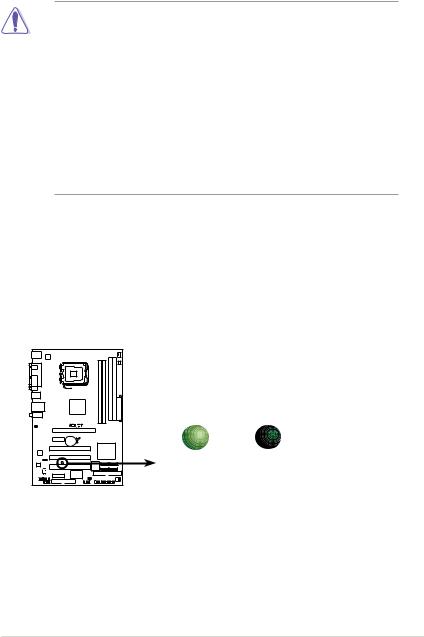
2.1Before you proceed
Take note of the following precautions before you install motherboard components or change any motherboard settings.
•Unplug the power cord from the wall socket before touching any component.
•Use a grounded wrist strap or touch a safely grounded object or to a metal object, such as the power supply case, before handling components to avoid damaging them due to static electricity.
•Hold components by the edges to avoid touching the ICs on them.
•Whenever you uninstall any component, place it on a grounded antistatic pad or in the bag that came with the component.
•Before you install or remove any component, ensure
that the ATX power supply is switched off or the power cord is detached from the power supply. Failure to do so may cause severe damage to the motherboard, peripherals, and/or components.
Onboard LED
The motherboard comes with a standby power LED. The green LED lights up to indicate that the system is ON, in sleep mode, or in soft-off mode. This is a reminder that you should shut down the system and unplug the power cable before removing or plugging in any motherboard component. The illustration below shows the location of the onboard LED.
P5PL2 |
SB_PWR |
|
ON |
|
OFF |
Standby |
Powered |
|
Power |
|
Off |
P5PL2 Onboard LED |
|
|
ASUS P5PL2 |
2-1 |
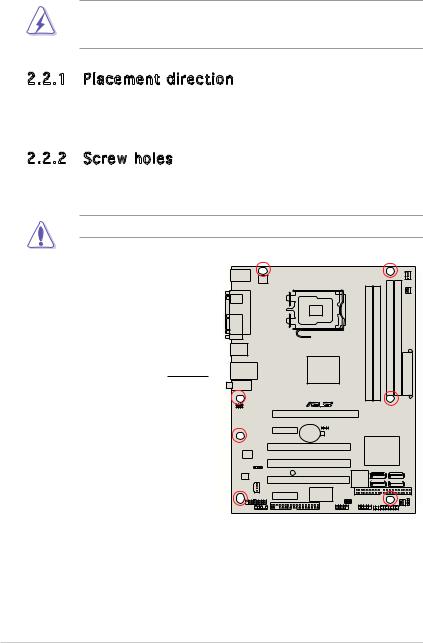
2.2Motherboard overview
Before you install the motherboard, study the configuration of your chassis to ensure that the motherboard fits into it.
Make sure to unplug the power cord before installing or removing the motherboard. Failure to do so can cause you physical injury and damage motherboard components.
2.2.1Placement direction
When installing the motherboard, make sure that you place it into the chassis in the correct orientation. The edge with external ports goes to the rear part of the chassis as indicated in the image below.
2.2.2Screw holes
Place seven (7) screws into the holes indicated by circles to secure the motherboard to the chassis.
Do not overtighten the screws! Doing so can damage the motherboard.
Place this side towards the rear of the chassis
P5PL2 |
2-2 |
Chapter 2: Hardware information |
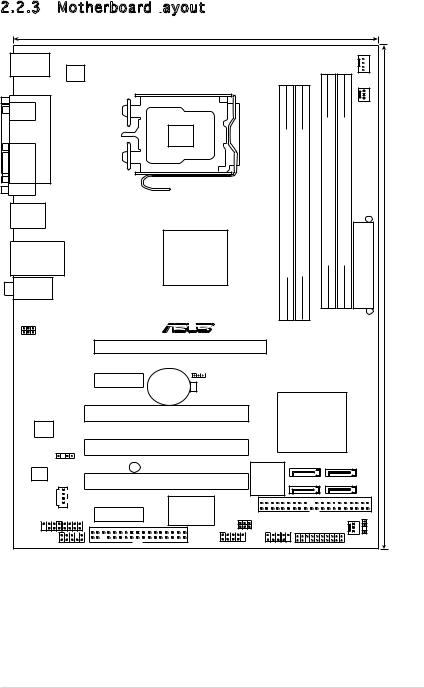
2.2.3Motherboard layout
|
|
18.8cm(7.5in) |
|
|
|
|
|
|
|
|
|
T:Mouse |
|
|
|
|
|
|
|
|
|
FAN |
|
PS/2KBMS |
|
|
|
|
|
|
|
|
|
CPU |
|
B:Keyboard |
|
|
|
|
|
|
|
|
|
|
|
|
|
|
|
|
|
|
|
|
|
|
|
ATX12V |
|
|
|
|
|
|
|
|
|
ANFR PW |
|
|
|
|
|
|
|
|
|
|
|
|
|
SPDIF_O |
|
LGA775 |
|
|
|
|
|
|
|
|
|
PARALLEL PORT |
|
|
|
|
bit,240-pin module) |
bit,240-pin module) |
64(bit,240-pin module) |
64(bit,240-pin module) |
|
|
|
COM1 |
|
|
|
|
|
|
|
|
|
|
|
USB12 |
|
|
|
P5PL2 |
DDR2 DIMM A1 (64 |
DDR2 DIMM A2 (64 |
DDR2 DIMM B1 |
DDR2 DIMM B2 |
EATXPWR |
30.5cm(12.0in) |
|
USBPW34 |
|
Intel MCH |
|
||||||||
LAN_USB34 |
|
945PL |
|
|
|
|
|
|
|
|
|
Top:Line In |
|
|
|
|
|
|
|
|
|
|
|
Center:Line Out |
|
|
|
|
|
|
|
|
|
|
|
Below:Mic In |
|
|
|
|
|
|
|
|
|
|
|
|
|
R |
|
|
|
|
|
|
|
|
|
USBPW12 |
|
|
|
|
|
|
|
|
|
|
|
|
|
PCIEX16 |
|
|
|
|
|
|
|
|
|
|
|
CLRTC |
|
|
|
|
|
|
|
|
|
|
PCIEX1_2 |
CR2032 3V |
|
|
|
|
|
|
|
|
|
|
|
Lithium Cell |
|
|
|
|
|
|
|
|
|
|
|
CMOS Power |
|
|
|
|
|
|
|
|
|
|
|
PCI1 |
|
|
Intel ICH7 |
|
|
|
|||
RLT8111B |
|
|
|
|
|
|
|
||||
|
|
|
|
|
|
|
|
|
|
|
|
SPDIF_OUT |
|
PCI2 |
|
|
|
|
|
|
|
|
|
Audio |
SB_PWR |
|
4Mb |
|
SATA1 |
SATA4 |
|
|
|
||
|
PCI3 |
|
|
SATA2 |
SATA3 |
|
|
|
|||
CD |
|
|
BIOS |
|
|
|
|
||||
|
|
Super I/O |
PRI_IDE |
|
|
|
|
|
|
|
|
GAME |
PCIEX1_1 |
|
|
|
|
|
CHA_FAN1 |
CHASSIS |
|
||
|
|
USBPW78 |
|
|
|
||||||
|
|
|
|
|
|
|
|
|
|||
|
|
|
|
USBPW56 |
|
|
|
|
|
|
|
AAFP |
FLOPPY |
|
USB56 |
USB78 |
PANEL |
|
|
|
|
||
ASUS P5PL2 |
2-3 |

2.2.4Layout contents
contents
|
Slots |
Page |
|
|
1. |
PCI-E x16 |
2-18 |
|
2. |
PCI-E x 1 |
2-18 |
|
3. |
PCI |
2-18 |
|
|
|
|
|
Jumpers |
Page |
|
|
1. |
Clear RTC RAM (3-pin CLRTC) |
2-20 |
|
2. |
USB Device wake-up (3-pin USBPW12, USBPW34, |
2-21 |
|
|
USBPW56, USBPW78) |
|
Rear panel connectors |
Page |
|
1. |
PS/2 mouse port (green) |
2-22 |
2. |
Parallel port |
2-22 |
3. |
LAN (RJ-45) port |
2-22 |
4. |
Line In port (light blue) |
2-22 |
5. |
Line Out port (lime) |
2-22 |
6. |
Microphone port (pink) |
2-22 |
7. |
USB 2.0 ports 3 and 4 |
2-23 |
8. |
USB 2.0 ports 1 and 2 |
2-23 |
9. |
Serial port (COM1) |
2-23 |
10. |
Coaxial S/PDIF Out port |
2-23 |
11. |
PS/2 keyboard port (purple) |
2-23 |
2-4 |
Chapter 2: Hardware information |

Internal connectors |
Page |
|
|
1. |
Floppy disk drive connector (34-1 pin FLOPPY) |
2-23 |
|
2. |
ICH7 Primary IDE connector (40-1 pin PRI_IDE) |
2-24 |
|
3. |
Serial ATA connectors (7-pin SATA1 [red], SATA2 [red], |
2-25 |
|
|
SATA3 [black], SATA4 [black]) |
|
|
4. |
Optical drive audio connector (4-pin CD) |
2-26 |
|
5. |
Front panel audio connector (10-1 pin AAFP) |
2-26 |
|
6. |
USB connectors (10-1 pin USB56, USB78) |
2-27 |
|
7. |
GAME/MIDI port connector (16-1 pin GAME) |
2-27 |
|
8. |
CPU, Chassis, and Power Fan connectors (4-pin CPU_FAN, |
2-28 |
|
|
3-pin CHA_FAN1, PWR_FAN) |
|
|
9. |
Chassis intrusion connector (4-1 pin CHASSIS) |
2-28 |
|
10. ATX power connectors (24-pin EATXPWR, 4-pin ATX12V) |
2-29 |
|
|
11. |
System panel connector (20-1 pin PANEL) |
2-30 |
|
System power LED (Green 3-pin PLED)
Hard disk drive activity LED (Red 2-pin IDE_LED)
System warning speaker (Orange 4-pin SPEAKER)
ATX power button/soft-off button (Yellow 2-pin PWRSW)
Reset button (Blue 2-pin RESET)
ASUS P5PL2 |
2-5 |

2.3Central Processing Unit (CPU)
The motherboard comes with a surface mount LGA775 socket designed for the Intel® Pentium® 4 processor in the 775-land package
•Upon purchase of the motherboard, make sure that the PnP cap is on the socket and the socket contacts are not bent. Contact your retailer immediately if the PnP cap is missing, or if you see any damage to the PnP cap/socket contacts/motherboard components. ASUS will shoulder the cost of repair only if the damage is shipment/ transit-related.
•Keep the cap after installing the motherboard. ASUS will process Return Merchandise Authorization (RMA) requests only if the motherboard comes with the cap on the LGA775 socket.
•The product warranty does not cover damage to the socket contacts resulting from incorrect CPU installation/removal, or misplacement/loss/incorrect removal of the PnP cap.
2.3.1Installing the CPU
the CPU
To install a CPU:
1.Locate the CPU socket on the motherboard.
P5PL2 |
P5PL2 CPU Socket 775 |
Before installing the CPU, make sure that the cam box is facing towards you and the load lever is on your left.
2-6 |
Chapter 2: Hardware information |
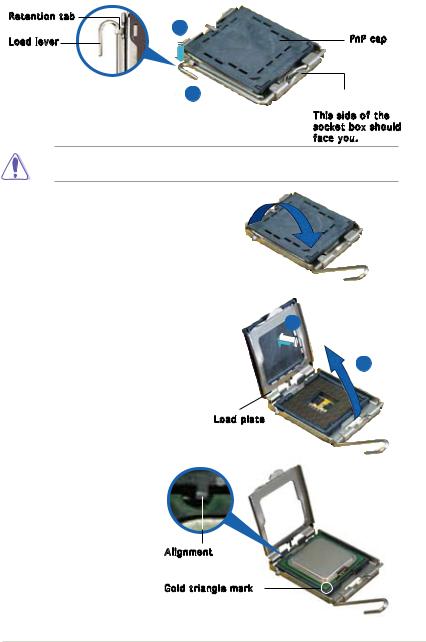
2.Press the load lever with your thumb (A), then move it to the left (B) until it is released from the retention tab.
Retention tab
A
Load lever |
PnP cap |
B
This side of the socket box should face you.
To prevent damage to the socket pins, do not remove the PnP cap unless you are installing a CPU.
3.Lift the load lever in the direction of the arrow to a 135º angle.
4.Lift the load plate with your
thumb and forefinger to a 100º |
B |
|
angle (A), then push the PnP cap |
||
|
||
from the load plate window to |
|
|
remove (B). |
A |
|
|
Load plate |
5.Position the CPU over the socket, making sure that the gold triangle is on the bottom-left corner of the socket. The socket alignment key should fit into the CPU notch.
Alignment 

Gold triangle mark
ASUS P5PL2 |
2-7 |
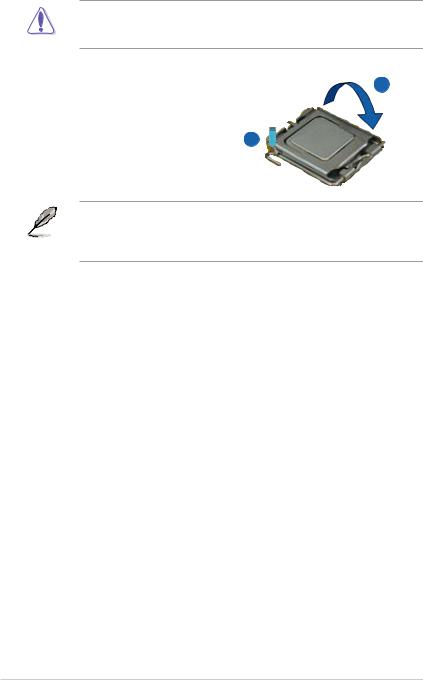
The CPU fits in only one correct orientation. DO NOT force the CPU into the socket to prevent bending the connectors on the socket and damaging the CPU!
6. Close the load plate (A), then |
A |
push the load lever (B) until |
|
it snaps into the retention |
|
tab. |
B |
|
The motherboard supports Intel® Pentium® 4 LGA775 processors with the Intel® Enhanced Memory 64 Technology (EM64T), Enhanced Intel SpeedStep® Technology (EIST), and Hyper-Threading Technology. Refer to the Appendix for more information on these CPU features.
2-8 |
Chapter 2: Hardware information |
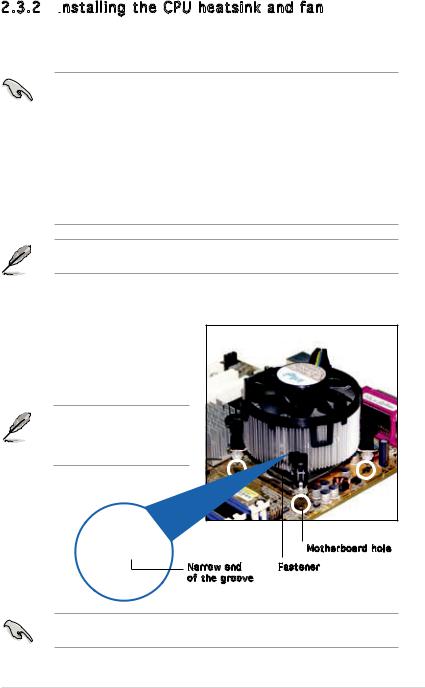
2.3.2Installing
 the CPU heatsink and fan
the CPU heatsink and fan
The Intel® Pentium® D LGA775 processor requires a specially designed heatsink and fan assembly to ensure optimum thermal condition and performance.
•When you buy a boxed Intel® Pentium® D processor, the package
includes the CPU fan and heatsink assembly. If you buy a CPU separately, make sure that you use only Intel®-certified multi-directional heatsink and fan.
•Your Intel® Pentium® D LGA775 heatsink and fan assembly comes in a push-pin design and requires no tool to install.
•If you purchased a separate CPU heatsink and fan assembly, make sure that you have properly applied Thermal Interface Material to the CPU heatsink or CPU before you install the heatsink and fan assembly.
Make sure that you have installed the motherboard to the chassis before you install the CPU fan and heatsink assembly.
To install the CPU heatsink and fan:
1.Place the heatsink on top of the installed CPU, making sure that the four fasteners match the holes on the motherboard.
Orient the heatsink and fan assembly such that the CPU fan cable is closest to the CPU fan connector
Motherboard hole
Narrow end |
Fastener |
of the groove |
|
Make sure to orient each fastener with the narrow end of the groove pointing outward. (The photo shows the groove shaded for emphasis.)
ASUS P5PL2 |
2-9 |

2. Push down two fasteners at |
|
|
||||
|
|
|||||
a time in a diagonal sequence |
B |
|||||
to secure the heatsink and fan |
||||||
|
||||||
assembly in place. |
|
|
A |
A |
||
|
|
|
|
B |
||
|
A |
B |
||||
B
A
3.Connect the CPU fan cable to the connector on the motherboard labeled CPU_FAN.

 CPU_FAN
CPU_FAN
GND
CPU FAN PWR
CPU FAN IN
 CPU FAN PWM
CPU FAN PWM
2P5PL
P5PL2 CPU Fan Connectors
Do not forget to connect the CPU fan connector! Hardware monitoring errors can occur if you fail to plug this connector.
2-10 |
Chapter 2: Hardware information |
